Drop 2 Voicings: 4-Note Wonders For Comping
 Would you like to learn a fast and easy way to use drop 2 voicings?
Would you like to learn a fast and easy way to use drop 2 voicings?
Want to move away from your ordinary triads in your comping?
If so, this is the lesson for you.
In this lesson, you’re going to learn a quick way to get those drop 2 voicings under your fingers.
With these two-handed drop 2 chord voicings, you’ll sound really hip, especially in jazz and blues.
Let’s get started.
Two Shapes That Unlocks Drop 2 Voicings
 To learn all of these voicings you only need two intervals: fourths and fifths.
To learn all of these voicings you only need two intervals: fourths and fifths.
That’s because fourths and fifths are the shapes that serve as building blocks for drop 2 voicings.
These intervals could be in their perfect, augmented, or diminished forms.
They would depend on the kind of chord you are playing.
Our first set of voicings is based on root position chords.
Basic Major Chord Drop 2 Voicing
Let’s start with a Cmaj7 chord.
Normally a Cmaj7 chord has the notes C, E, G, and B:
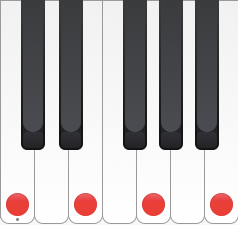
Sounds nice, right? True, but it’s rather ordinary.
Let’s revoice that one-handed chord into a more exciting two-handed version.
Play G and C with the left hand then E and B with the right hand like this:
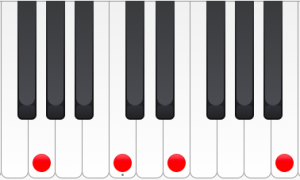
Now the chord sounds more sophisticated already.
Our drop 2 major chord voicing formula then is as follows:
LH Perfect 4th <—> 3 half steps <—> RH Perfect 5th
Basic Minor Chord Drop 2 Voicing
Now let’s try a Cm7 chord. Its notes are C, Eb, G, and Bb:
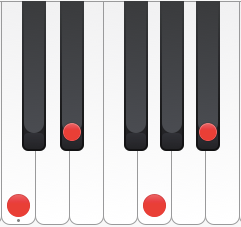
Now try playing the same chord as G and C using the left hand and then Eb and Bb for the right:
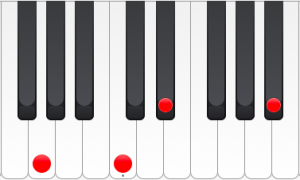
Our drop 2 minor chord voicing formula then is as follows:
LH Perfect 4th <—> 2 half steps <—> RH Perfect 5th
Basic Dominant Chord Drop 2 Voicing
Let’s now try a C7 chord.
The C7 chord has the notes C, E, G, and Bb:
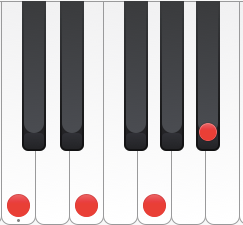
The C7 chord that’s in a drop 2 voicing has G and C for the left hand and then E and Bb for the right hand:
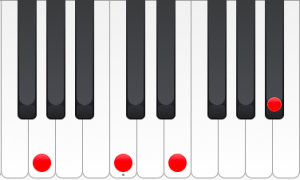
Our drop 2 dominant chord voicing formula then is as follows:
LH Perfect 4th <—> 3 half steps <—> RH diminished 5th
Basic Minor 7 (b5) Drop 2 Voicing
A Cm7(b5) chord has C, Eb, Gb, and Bb:
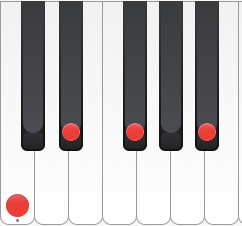
To turn this into a drop 2 voicing, play Gb and C with the left hand and Eb and Bb with the right:
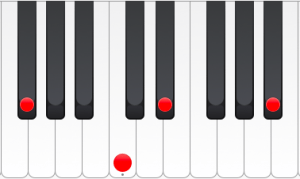
Our drop 2 minor 7th (b5) chord voicing formula then is as follows:
LH diminished 5th <—> 2 half steps <—> RH Perfect 5th
Practice these voicings and learn them in all 12 keys. Once you’ve done that, you’ll now have the building blocks for many drop 2 voicings.
Why Do We Call These Chords Drop 2 Voicings?
 You were able to play both drop 2 voicings by simply dropping the 2nd highest note of any 4-note chord an octave lower.
You were able to play both drop 2 voicings by simply dropping the 2nd highest note of any 4-note chord an octave lower.
That’s the reason why we call them drop 2 voicings,
To make things easier, here’s another way of looking at these chord voicings. Read on.
How Thelonious Monk Used Drop 2 Voicings
 This alternative to elementary triads is simply wonderful.
This alternative to elementary triads is simply wonderful.
They are so effective that they are part of every legend’s bag of tricks.
Take a listen to how Thelonious Monk used drop 2 voicings.
Check out this studio recording of “Ruby, My Dear”:
Look at the first few measures of the tune to see how he used them to great effect to go from one key to another:
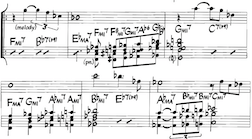
The “Ruby, My Dear” formula for playing drop 2 voicings is:
- Play root and 5th with the left hand.
- Play 7th (or 6th) and 3rd with the right hand.
If you look at these voicings carefully, they’re actually drop 2 versions of 2nd inversion chords.
This formula works on any chord and can be used for jazz, blues, rock, and pop.
The amazing thing about Thelonious Monk’s drop 2 voicings is that they are simpler to play. This is because they are always in root position.
Let’s look at “Ruby, My Dear” voicings for Cmaj7, Cm7, C7, and Cm7(b5):
“Ruby, My Dear” Major 7: CMaj7
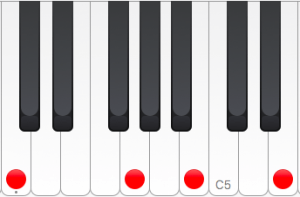
C – G – B – E
LH Root + 5th <—> 3 half steps <—> RH Perfect 4th
“Ruby, My Dear” Minor 7: Cm7
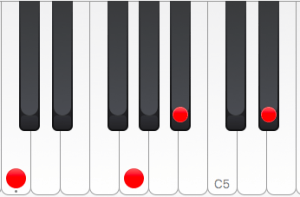
C – G – Bb – Eb
LH Root + 5th <—> 2 half steps <—> RH Perfect 4th
“Ruby, My Dear” Dominant 7: C7
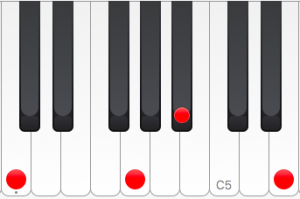
C – G – Bb – E
LH Root + 5th <—> 2 half steps <—> RH Augmented 4th
“Ruby, My Dear” Minor 7(b5): Cm7(b5)
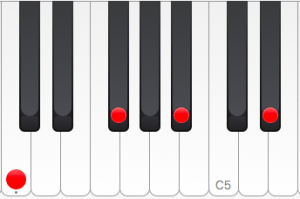
C – Gb – Bb – Eb
LH Root + flat 5th <—> 2 half steps <—> RH Perfect 4th
 Speaking of Thelonious Monk, if you want to learn some of his greatest hits I highly recommend Premium Jazz Lessons Elite Membership.
Speaking of Thelonious Monk, if you want to learn some of his greatest hits I highly recommend Premium Jazz Lessons Elite Membership.
Inside Premium Jazz Lessons, you can learn 3 full arrangement levels of every song. That way players of all levels can improve their chops without having to play stuff that’s too easy or too hard. You can find the perfect jazz piano growth plan.
Get instant access to Premium Jazz Lessons here.
Before moving to the next tip, practice and learn the chord voicings above in all 12 keys.
How To Practice Drop 2 Voicings In All Keys
 The best way to practice these chords is by playing them using smooth voice leading in circle progressions.
The best way to practice these chords is by playing them using smooth voice leading in circle progressions.
The best tune that utilizes circle progressions is the A section of Autumn Leaves.
Start playing the Autumn Leaves chord progression in C using drop 2 voicings. The chords are Dm7 – G7 – Cmaj7 – Fmaj7 – Bm7(b5) – E7 – Am7:

This chord progression takes you through all of the existing chords in a major key as well as the relative minor.
Another cool thing about practicing this way is that the last chord, Am7, is the ii of G.
This allows you to easily change key from C to G.
Now try playing the same chord progression in the key of G:

Keep working your way through the pattern and you’ll be able to practice along the circle of 5ths. You can cover all 12 keys this way. You can also get instant access to in-depth Autumn Leaves arrangements inside Premium Membership too.
Want to spice up these chords with extensions? Read on.
A Simple Formula For Rootless Versions
Following the example of the legendary Ray Charles, we can make things a lot simpler for these chords:
- Play the 3rd and the 7th of the chord for the left hand only.
- Play a 5th and an extension or 2 extensions using the right hand.
Follow the same rule to make things easy for you.
Let’s look at a G7(13,9) chord this time.
If you play this chord rootless and skip the 5th, you’ll have B, E, F, and A:
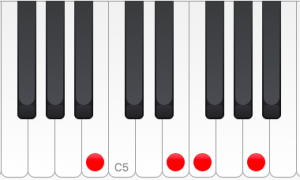
The minor 2nd between E and F sounds annoying, right? So, drop that F to a lower octave:
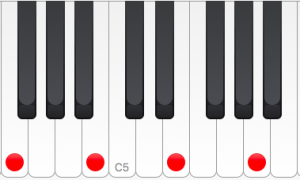
If you drop that F, you’ll have F and B for the left hand and E and A for the right hand.
F and B are the flat 7th and major 3rd of G, and E and A are the 13th and 9th respectively.
If you look at the shape, F and B are an augmented 4th apart and E and A are a perfect 4th apart.
Here’s An Even Simpler Way Of Playing Rootless Drop 2 Voicings
Think of your chord voicings with roots as rootless chord voicings. Here’s how you can do it:
- Major 7 chord voicings with root can function as rootless relative minor 7 chord voicings. For example, the drop 2 Cmaj7 chord voicing automatically works as Am7(9):

- Minor 7 (b5) chord voicings with root can function as rootless dominant 7 chord voicings two half steps above. For example, the drop 2 Cm7(b5) can work as a D7(b13,b9):

- Minor 7 chord voicings with root can function as rootless major 7th chord voicings a major 6th above the original root. For example, the drop 2 Bm7 chord works as Gmaj7(9):
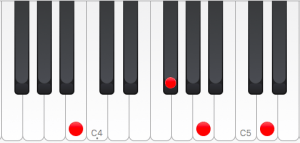
- A stack of four notes separated as 4ths can function as a major 7 a half step above the root with a 13th and 9th. For example, a stack of 4ths from B works as a Cmaj7(13,9):
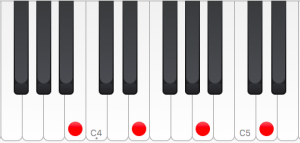
- Minor 6 chord voicings with root can function as a minor 7 (b5) found a major 3rd above the original root. For example, a Am6 can function as an F#m7(b5):
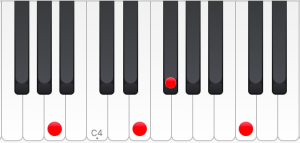
- A minor 7(b5) voicing with its root can function as a rootless dominant 7th(b13)(b9) found a major 2nd above. For example, an Am7(b5) voicing works as a rootless B7(b13,b9) chord:
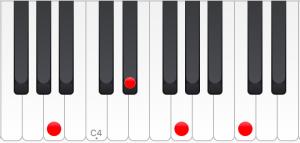
- Again, a major 7 chord voicing can function as a rootless minor 7. Here’s a Gmaj7 functioning as an Em7(9):
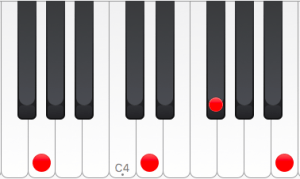
Here’s an “easter egg” for you: Learn all of the chords above, and you’ll have a rootless “Autumn Leaves” chord progression in drop 2 voicings.
 And by the way, Ray Charles was a true master of this voicing technique. Especially when combined with a locked hands technique.
And by the way, Ray Charles was a true master of this voicing technique. Especially when combined with a locked hands technique.
Speaking of Ray Charles, if you want to learn more of his amazing tricks, check out Play Like Ray.
Inside Play Like Ray, you’ll discover all kinds of Ray Charles harmony moves, licks, grooves, songs, and chords. It’s the most comprehensive Ray Charles course in the world.
Learn how to Play Like Ray here.
Now that you have some great starting points for drop 2 chords, how do you make real music with them?
Why You Feel Disconnected (And What To Do About It)
 Do you feel like you’re spinning your wheels in the practice room?
Do you feel like you’re spinning your wheels in the practice room?
Do you know deep down there is so much more you could be doing with your music?
You’re not alone. It’s a common problem and can be easily solved with the right training.
And that’s exactly why we created the 1 on 1 Jazz Inner Circle mentorship program.
If you think you’d be benefit from being mentored by a world touring jazz pro, Grammy Nominees or a Platinum Selling Artist, then I encourage you to apply for this exclusive program right here.
The Jazz Inner Circle provides the perfect opportunity to work 1-on-1 with world-class jazz piano instructors all in the comfort of your own home.
==> Apply for this exclusive 1-on-1 program here.
Drop 2 Final Thoughts
I hope that you enjoyed this lesson on drop 2 voicings.
If you have anything else to add to this lesson, have any comments, or suggestions for the next one, feel free to leave a comment below.
Now it’s time to go from concepts to practice. It’s time to hit those keys and get some work done.
As always, we’re always here to help you be the best jazz pianist you can be.
